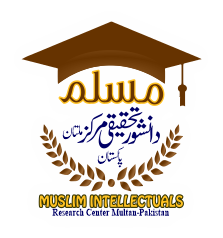THE ROLE OF SYED ALI HAMDANI IN THE REFORMATION OF BALTISTAN SOCIETY: A HISTORICAL AND ANALYTICAL REVIEW
Keywords:
Role, Syed Ali Hamdani, Society of Baltistan, Historical & Analytical, Karakoram.Abstract
This study explores the role of Syed Ali Hamdani in the reformation of Baltistan society, tracing his profound influence on the region's religious, cultural, and socio-political landscape. Syed Ali Hamdani, a revered Sufi scholar and missionary of the 14th century, played a pivotal role in introducing Islam to Baltistan, shaping its spiritual and societal structure. His teachings and missionary work laid the foundation for Islamic practices, leading to the gradual transformation of the local population from their earlier religious beliefs to Islam. His successors, including Syed Muhammad Noor Bakhsh and Mir Shamsuddin Iraqi, further propagated his teachings, solidifying Islamic influence in the region.
The research provides a historical and analytical review of Hamdani’s contributions, highlighting his establishment of mosques, Khanqahs, and educational institutions that became centers for religious learning and governance. His emphasis on Sufi principles of justice, morality, and spiritual enlightenment significantly altered the cultural and ethical framework of Baltistan. Additionally, the study examines the socio-political changes triggered by his influence, including the rise of Islamic jurisprudence and governance models that reshaped the traditional structures of power in Baltistan.
By drawing from historical manuscripts, local traditions, and scholarly works, this paper underscores the lasting impact of Syed Ali Hamdani's efforts in shaping Baltistan’s identity. His role in promoting literacy, economic self-sufficiency, and social harmony through Islamic teachings remains a cornerstone of the region’s historical evolution. The study concludes that his legacy continues to be a defining element of Baltistan’s cultural and religious heritage, with his teachings still resonating in contemporary religious and social practices.
Downloads
References
Karakoram: This word comes from the Turkish language, meaning "black rock" (Hussain Abadi, History of Baltistan: 28).
K2: It is the second highest peak in the world, standing at 28,250 feet. It is located in the Karakoram range, 125 miles from Skardu. In the Balti language of Baltistan, K2 is referred to as Chogori, which means "big mountain." There are three hundred peaks in this range, with one hundred peaks reaching heights between 20,000 and 28,000 feet. When these peaks were measured, the tallest were named Karakoram No. 1 and Karakoram No. 2. Thus, the peaks Mashabrum, Wun, and Chogori were designated as K2. K2 is situated on the border of Baltistan and Xinjiang, above the Godwin-Austen Glacier. It was first summited on July 31, 1954, by two Italian climbers (Hussain Abadi, History of Baltistan: 28).
Hussain Abadi, Y. (2019). Tarikh Baltistan. Baltistan Book Depot.
Hussain Abadi, Y. (2019). Tarikh Baltistan. Baltistan Book Depot.
Hussain Abadi, Y. (2019). Tarikh Baltistan. Baltistan Book Depot.
Hussain Abadi, Y. (2019). Tarikh Baltistan. Baltistan Book Depot.
Hussain Abadi, Y. (2019). Tarikh Baltistan. Baltistan Book Depot.
Hussain Abadi, Y. (2019). Tarikh Baltistan. Baltistan Book Depot.
Hussain Abadi, Y. (2019). Tarikh Baltistan. Baltistan Book Depot.
Hussain Abadi, Y. (2019). Tarikh Baltistan. Baltistan Book Depot.
Hussain Abadi, Y. (2019). Tarikh Baltistan. Baltistan Book Depot.
Hussain Abadi, Y. (2019). Tarikh Baltistan. Baltistan Book Depot.
Ibn Khaldun, A. (2001). Tarikh Ibn Khaldun (Vol. 2). Nafis Academy.
Masudi, A. H. (1985). Muruj al-Dhahab wa Ma’adin al-Jawhar. Nafis Academy.
Hussain Abadi, Y. (2019). Tarikh Baltistan. Baltistan Book Depot.
Masudi, A. H. (1985). Muruj al-Dhahab wa Ma’adin al-Jawhar. Nafis Academy.
Masudi, A. H. (1985). Muruj al-Dhahab wa Ma’adin al-Jawhar. Nafis Academy.
Hasno, G. H. (2023). Tarikh Baltistan (Vol. 1). Haroon Books & Sports Center.
Ibrahim Abdullah. Baltistan mein Ashaat-e-Islam ka Tahqiqi Jaiza (Unpublished manuscript). Ghulam Hassan Hasno.
Hasno, G. H. (2023). Tarikh Baltistan (Vol. 1). Haroon Books & Sports Center.
Hussain Abadi, Y. (2019). Tarikh Baltistan. Baltistan Book Depot.
Hayat, M. (2006). Tarikh Iran Qadeem. Lahore.
Hussain Abadi, Y. (2019). Tarikh Baltistan. Baltistan Book Depot.
Hasno, G. H. (2023). Tarikh Baltistan (Vol. 1). Haroon Books & Sports Center.
Ghani, S. (2005). Ladakh Tahzeeb-o-Saqafat. Jammu.
Gautam Buddha Se Dalai Lama Tak.
Gautam Buddha Se Dalai Lama Tak.
Hussain Abadi, Y. (2019). Tarikh Baltistan. Baltistan Book Depot.
Hussain Abadi, Y. (2019). Tarikh Baltistan. Baltistan Book Depot.
Wazir Ahmad Ghazwa. (2000). Habl al-Matin (p. 12).
Syed Iraqi Shigar. (2001). Nour al-Mu’minin (p. 442).
Salim Khan Gami. (2003). Islamic Propagation in Kashmir (p. 30). Lahore.
Al-Bukhari, Abdullah Muhammad bin Ismail. (1981). Sahih al-Bukhari (No. 3636). Dar al-Fikr for Publishing and Distribution, Beirut, Lebanon.
Baladhuri, Ahmad bin Yahya. (1319 AH). Futuh al-Buldan (pp. 115). Egypt. (as cited in Ghous Ali Shah Qalandar, Taleem al-Ghausiyyah, p. 115; Sheikh Abdul Qadir, Adab al-Suluk, p. 85).
Ibn Khaldun, Abdul Rahman. (1987). History of Ibn Khaldun (Translated by Hakim Ahmad Hussain Al-Abadi, Vol. 1, p. 379). Nafis Academy, Karachi.
Ibn Khaldun, Abdul Rahman. History of Ibn Khaldun (p. 406).
Ibn Khaldun, Abdul Rahman. History of Ibn Khaldun (Translated, Vol. 1, p. 416).
Ibn Khaldun, Abdul Rahman. History of Ibn Khaldun (Translated, Vol. 1, pp. 415-418).
Ibn Khaldun, Abdul Rahman. History of Ibn Khaldun (Vol. 2, p. 178).
Ibn Khaldun, Abdul Rahman. History of Ibn Khaldun (Vol. 2, p. 213).
Ibn Khaldun, Abdul Rahman. History of Ibn Khaldun (Vol. 2, pp. 219, 213).
Ibn Khaldun, Abdul Rahman. History of Ibn Khaldun (Vol. 2, pp. 224-225).
Ibn al-Athir, al-Hassan Ali bin Abdul Karim. Al-Kamil fi al-Tarikh (Vol. 4, p. 425). Dar Sader, Beirut, Lebanon.
Baladhuri, Ahmad bin Yahya. Futuh al-Buldan (Chapter on the Opening of Sindh) (as cited in History of Ibn Khaldun, Vol. 2, p. 218).
Ibn Khaldun, Abdul Rahman. History of Ibn Khaldun (Vol. 2, pp. 234-232).
Ibn Khaldun, Abdul Rahman. History of Ibn Khaldun (Vol. 2, pp. 243, 244, 274).
Ibn Khaldun, Abdul Rahman. History of Ibn Khaldun (Vol. 3, p. 56).
Ibn Khaldun, Abdul Rahman. History of Ibn Khaldun (Translated, pp. 201-202).
Yabgo Fath Ali Khan. History of the Khaplu Nations (p. 3).
Muhammad Din Foq. (1993). History of the Kashmir Nations (p. 49). Mirpur, Pakistan.
Syed Muhammad Abbas Kazmi. Balti Folk Songs (p. 9).
Nooruddin Jafar Badakhshi. Khilasah al-Manaqib (p. 3). Persian Research, Islamabad. Nour al-Mu’minin (p. 444).
Arnold, T. W. (2004). The Preaching of Islam (Translated by Sheikh Anayatullah, pp. 262-263). Lahore.
Syed Ali Hamdani (Ph.D. Thesis). Syeda Ashraf Zafar Bukhari. (p. 131). Nida-ul-Masaneef, Lahore.
Hussain Abadi, Y. (2019). History of Baltistan (p. 49).
Hasno, G. H. (2023). History of Baltistan (p. 143).
Mir Najmuddin Thaqib. Nour al-Mu’minin (p. 444).
Hussain Abadi, Y. (2019). History of Baltistan (p. 49).
Hasno, G. H. (2023). History of Baltistan (p. 130).
Badakhshi, Nooruddin Jafar. Civilization and Culture of Ladakh (pp. 350-357).
Hashmatullah. History of Jammu (p. 681). Lahore.
Arnold, T. W. (2004). The Preaching of Islam (p. 316).
Badakhshi, Nooruddin Jafar. Civilization and Culture of Ladakh (p. 357).
Arnold, T. W. (2004). The Preaching of Islam (p. 316).
Roberts, C. (2006). To Dalai Lama (Translated by Muhammad Ahsan Butt, pp. 43-44). Lahore.
Fida Hussain. Mir Syed Ali Hamdani (p. 33).
Khawar, Abdul Hamid. Khawar Nama (p. 46).
Shamim Baltistani. Ain-e-Baltistan (p. 25).
Shah Rais Khan. History of Gilgit (pp. 34-35). Islamabad, 1987.
Hussain, U. A. Professor of Northern Pakistan (p. 198).
Hasno, G. H. (2019). History of Baltistan (p. 119).
Hashmatullah. History of Jammu (p. 681).
Burosho Tribes and Buroshal (p. 157). History of Gilgit (p. 95).
Azizuddin Manshi. History of Chitral (p. 24).
Abadi, Y. H. (n.d.). A glance at Baltistan. 125.
Hasno, G. H. (2023). History of Baltistan. 129.
Hasno, G. H. (2023). History of Baltistan. 134.
Hasno, G. H. (2023). History of Baltistan. 164.
Ibrahim, M. (n.d.). Karakoram Hindu Kush. 203.
Hasno, G. H. (2023). History of Baltistan. 138.
Kashmiri, M. A. (n.d.). Tuhfat al-Ahbab [Manuscript]. 540.
Najeem, M. (n.d.). Noor al-Mu'mineen. 446.
Hasno, G. H. (2023). History of Baltistan. 148.
Hashmatullah, M. (n.d.). History of Jammu. 590.
Hashmatullah, M. (n.d.). History of Jammu. 450.
Shami, F. H. (2023). Shamim: A mirror of Baltistan. 7.
Hashmatullah, M. (n.d.). History of Jammu. 590.
Hasno, G. H. (2023). History of Baltistan. 154.
Hashmatullah, M. (n.d.). History of Jammu. 450.
Saadi, M. (n.d.). Jalwa Kashmir. 105.
Hashmatullah, M. (n.d.). History of Jammu. 590.
Aafaqi, S. (n.d.). Jalwa Kashmir. 105.
Kashmiri, M. A. (n.d.). Tuhfat al-Ahbab [Manuscript]. 177.
Noor al-Mu'mineen. (n.d.). 445.
Baharistan Shahiy. (n.d.). 69.
Noor al-Mu'mineen. (n.d.). 445.
Kashmiri, M. A. (n.d.). Tuhfat al-Ahbab. 177.
Kashmiri, M. A. (n.d.). Tuhfat al-Ahbab. 189.
Hasno, G. H. (2023). History of Baltistan. 159.
Kashmiri, M. A. (n.d.). Tuhfat al-Ahbab [Manuscript]. 189.
Aafaqi, S. (n.d.). History of Muslim rule in Kashmir. 74. Lahore.
Hasno, G. H. (2023). History of Baltistan. 229. Citing Aurad Amiriya. 140.
Abadi, M. Y. H. (n.d.). A glance at Baltistan. 47.
Baharistan Shahiy. (n.d.). 35.
Noor al-Mu'mineen. (n.d.). 427.
Hasno, G. H. (2023). History of Baltistan. 232.
Hasno, G. H. (2023). History of Baltistan. 160.
Kashmiri, M. A. (n.d.). Tuhfat al-Ahbab [Manuscript]. 189.
Aafaqi, S. (n.d.). History of Muslim rule in Kashmir. 125. Lahore.
Hashmatullah, M. (n.d.). History of Jammu. 683.
History of Chitral (p. 26).
Aafaqi, S. (1992). History of Kashmir (p. 359). Lahore.
Najeem, M. (n.d.). Noor al-Mu'mineen (p. 444).
History of Jammu (p. 592).
Abadi, Y. H. (1987). A glance at Baltistan (p. 45). Skardu.
Kargil was part of Baltistan until the 10th century AH. Syed Noor Bakhsh had already introduced Islam while traveling from Khaplu to Kargil. In 1948, the people of Baltistan seized control during the freedom struggle.
Hussain Abadi, Y. H. (n.d.). A glance at Baltistan (p. 137).
Hashmatullah, M. (n.d.). History of Jammu (p. 590).
Ghani Shakh. (2005). Ladakh: Civilization and culture (p. 185). Jammu.
Ladakh in the eyes of researchers and travelers (p. 39).
Kazmi, S. A. (1989). Letter to Hasno (15 July).
Noor Bakhsh, S. M. (m. 869 AH). Mashjar al-Awliya (2, 4).
Hasno, G. H. (2023). History of Baltistan (p. 176). The Dard people inhabit the districts of Gilgit and Diamer, which were once referred to as Dard or Dardistan.

Downloads
Published
Issue
Section
License
Copyright (c) 2024 PAKISTAN ISLAMICUS (An International Journal of Islamic & Social Sciences)

This work is licensed under a Creative Commons Attribution 4.0 International License.
This work is licensed under a Creative Commons Attribution 4.0 International License.
































